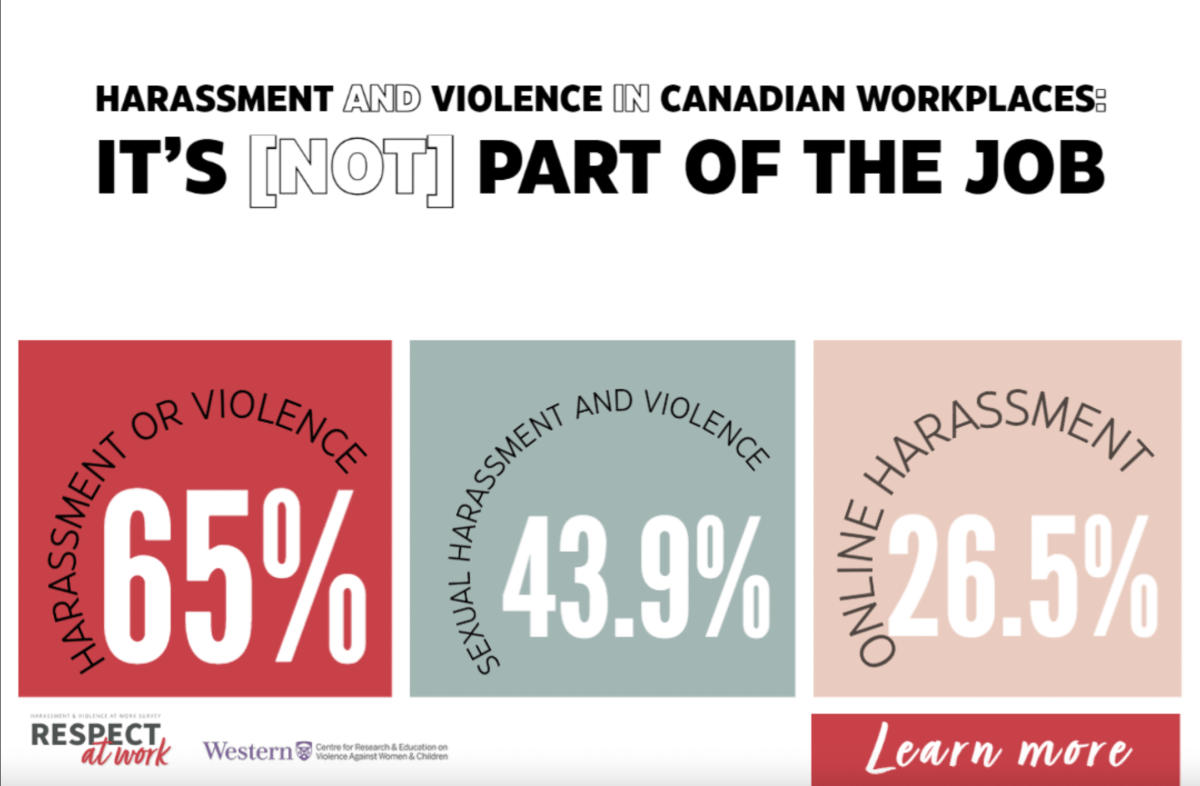A new study from Western University has found that almost three-fourths of employees reported experiencing at least one form of violence and sexual harassment.

The Respect at Work: Harassment and Violence in Canadian Workplaces study was a partnership between Western University’s Centre for Research and Education on Violence Against Women and Children (CREVAWC) at Western University, researchers from the University of Toronto, and the Canadian Labour Congress.
The survey includes responses from 4,878 workers from Oct. 21, 2020 to April 21, 2021, as well as interviews from 34 participants recruited through networks of the Canadian Labour Congress and its affiliates and through social media.
“Despite the concerted efforts of so many people from so many perspectives, sadly, this report tells us that even today, many survivors are receiving the same non-response as Sharon Chapman did when she first reached out to me for support. We can do better,” said Barb MacQuarrie, community director of the CREVAWC.
MacQuarrie was referring to a woman who reported being harassed and sexually assaulted by co-workers and went to report the harassment but at the time there was no sustained response or support in place.
Flash forward to over 20 years later and researchers looked at three categories of workplace sexual harassment and violence: harassment and violence that was non-sexual in nature, sexual harassment and violence, and online harassment and violence.
The study showed at 71.4 per cent of respondents experienced at least one form of harassment and violence or sexual harassment and violence in the two years prior to completing the survey.
It also showed that 65 per cent of respondents experienced at least one behaviour or practice of harassment or violence while 43.9 per cent had experienced at least one behaviour or practice of sexual harassment and violence in the past two years.
The study focused on a specific sub-group of workers with approximately 88 per cent of survey participants being union members, compared with about 31 per cent of workers nationally. The three most common sectors indicated by survey participants were education, health care and social services and public administration.
At least 73 per cent of gender-diverse respondents experienced harassment and violence, compared with 46 per cent of those identifying as women and 38 per cent of men.
“Approximately two in five survey participants stated they experienced sexual harassment and sexual violence that ranges from sexual jokes to unwelcome touching to sexual assault, and just over one quarter experienced various online forms of harassment,” said Sandy Welsh, professor of sociology at the University of Toronto.
- Honda expected to announce Ontario EV battery plant, part of a $15B investment
- Trudeau says ‘good luck’ to Saskatchewan premier in carbon price spat
- Canadians more likely to eat food past best-before date. What are the risks?
- Hundreds mourn 16-year-old Halifax homicide victim: ‘The youth are feeling it’
Welsh also noted the survey found that members of the LGBTQ2 community, Indigenous workers, those living with disabilities and some racialized workers are more likely to experience all forms of harassment and violence, including sexual harassment, compared with other workers.
The survey also showed that COVID-19 and a transition to working from home did not stop harassment in most cases.
“For about 20 to 25 per cent of survey participants, the pandemic made things worse in certain areas. It increased the severity, the frequency, and it increased their fear of reporting and the tactics used by their harasser and perpetrator,” Welsh said.
She noted that about 19 per cent reported that COVID-19 had decreased the ways that were available to them to report their experiences.
“It’s also important to note that for a small percentage of our survey participants, the pandemic brought some relief from a toxic work environment. As one worker interviewed told us, ‘The pandemic still had a beneficial effect because I didn’t have to go to the office every day,'” she said.
As many employees look at what the future of work will look like after COVID-19, researchers noted concerns raised in this new study should also be taken into consideration.
“I think something that we really need to consider as many workplaces are either completely going virtual or adopting hybrid kinds of models for their workplaces. It’s really important that we think about how we can increase education and awareness for workers who are physically at work and also virtually,” said Adriana Berlingieri, academic research associate at the CREVAWC.









Comments